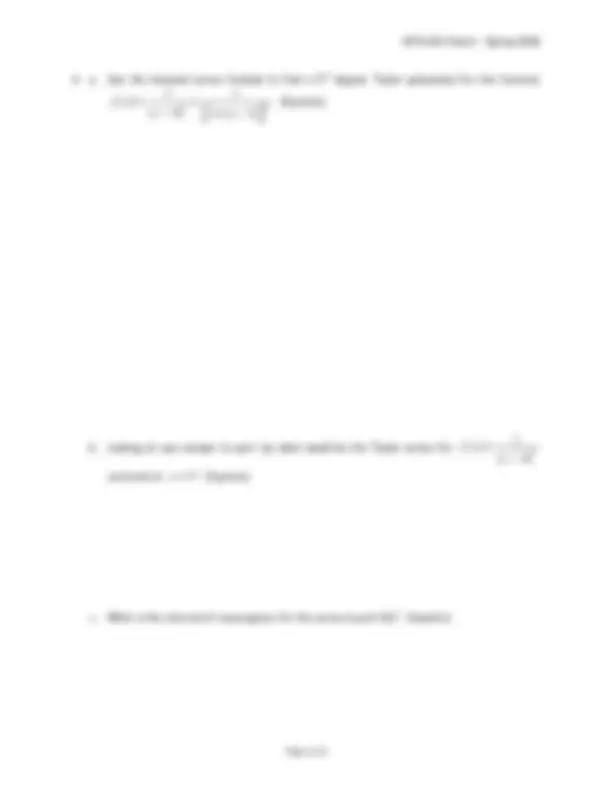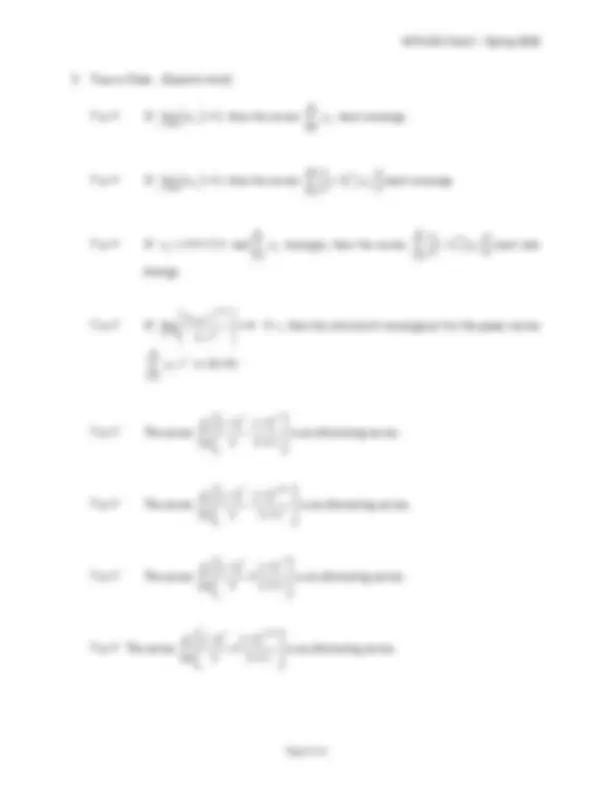






Study with the several resources on Docsity

Earn points by helping other students or get them with a premium plan


Prepare for your exams
Study with the several resources on Docsity

Earn points to download
Earn points by helping other students or get them with a premium plan
Community
Ask the community for help and clear up your study doubts
Discover the best universities in your country according to Docsity users
Free resources
Download our free guides on studying techniques, anxiety management strategies, and thesis advice from Docsity tutors
Material Type: Exam; Class: Calculus III; Subject: Math; University: Portland Community College; Term: Spring 2006;
Typology: Exams
1 / 8

This page cannot be seen from the preview
Don't miss anything!





All work on this test will be evaluated for your style of presentation as well as for the "correctness" of your "answer." Follow the writing guidelines established during lecture and spelled out in your Test 2 guide. To receive full credit all relevant algebra steps must be shown on the paper.
2
1
k k
k k
∑ (^) + and state an appropriate conclusion. (10 points)
` ( ) 1 2
k
k k
∑ (^) + is.
1
k
k
k k
∑ is^.
( )^3 1
k
k k
∑ is^.
( ) ( )
1 1
ln 1
k k k
∑ (^) + is.
( ) 1
sin k
k k
∞ π ∑= is.
( ) 1 (^ )
k
k k k
∑ (^) + is.
( ) 1
k
k k
k k
∑ (^) ⋅ + is.
( ) ( ) (^2) ( )^2
f x x (^) x
. (8 points)
b. Looking at your answer to part (a), what would be the Taylor series for ( ) ( )^2
f x x
centered at x = 5? (3 points)
c. What is the interval of convergence for the series in part (b)? (4 points)
T or F If (^) k lim → ∞ ak = 0 , then the series k 1^ k
a
∞ ∑= must converge.
T or F If (^) k lim → ∞ ak = 0 , then the series (^) ( ) 1
1 k k k
a
∑ (^) ⎣ ⎦must converge.
T or F If ak > 0 ∀ k ≥ 1 and k 1^ k
a
∑ diverges, then the series^ (^ ) 1
1 k k k
a
∑ (^) ⎣ ⎦ must also diverge.
T or F If
1 lim^1
k k k (^) k k
a x x a x
→ ∞ = ∞ ∀^ , then the interval of convergence for the power series
0 k^ k k
a x
∑ is^ (^ ∞ ∞,^ ).
T or F The series (^ )^ (^ ) 1
k k
k k^ k
∑ (^) ⎢⎣ + ⎥⎦ is an alternating series.
T or F The series (^ )^ (^ )^
1
1
k k
k k^ k
∑ (^) ⎢⎣ + ⎥⎦ is an alternating series.
T or F The series (^ )^ (^ ) 1
k k k k^ k
∑ (^) ⎢⎣ + ⎥⎦ is an alternating series.
T or F The series (^ )^ (^ )^
1 1
k k k k^ k
∑ (^) ⎢⎣ + ⎥⎦ is an alternating series.
All work on this test will be evaluated for your style of presentation as well as for the "correctness" of your "answer." Follow the writing guidelines established during lecture and spelled out in your Test 2 guide. To receive full credit all relevant algebra steps must be shown on the paper.
the series (^ ) 1
1 k k kk
∑ until you have established the value of^
( ) 1
1 k k kk
∑ accurate through the 3^ rd digit after the decimal point. State this value and how you know that you’ve established said value. (12 points)
2 1 0
sin 2 1!
k (^) k k
u u k
to help you find the Maclaurin
1/ 2 (^5 )